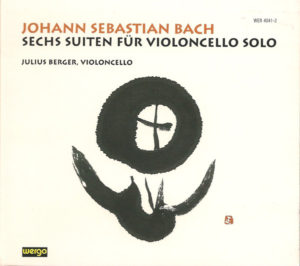
Julius Berger. Bach Cello Suites. Wergo CD WER4041-2.
Released 1997. Recorded between April 1995 and March 1996 at San Vigilo, Col San Martino Treviso Italy.
Instruments used: for Suites 1-5 Johan Baptist Guadagnini ex Davidoff 1780.
for Suite 6, five string cello by Jan Pieter Rambouts, 1700.
The Cellist.
Julius Berger was born in 1954 and has certainly had an illustrious career to date. Highlights include working with Antonio Janigro when aged 25 and making a lifelong project of bringing the works of Boccherini, to greater attention. He has recorded the Bach Suites twice, this being the second. There is a very clear distinction between the two recordings separated by 10 years or so. The first would fall into mainstream possibly romantic territory. This second recording is of Baroque style with gut strings, lowered pitch of tuning, and possibly period bow. Here is a link to an article which makes several comparisons between the two recordings. http://juliusberger.de/albums/j-s-bach-suiten-fuer-violoncello-solo/
The Recording.
Overall, I would judge this to be an excellent recording with a “clean” sounding acoustic. Whilst there is no escaping the fact that the recording was made in a Chapel, there is not excessive reverberation, which sometimes mars such recordings. There is the raspy sound of the gut strings but less of the harmonics often created. I did wonder if there was some dampening of the sound. The result is that faster movements such as Courantes sound very well-articulated and distinct in the notation.
What I would describe as a quirk is the impression that the cellos used have two voices. One for the top two strings and one for the lower two strings. The latter are very sonorous and a bit gruff, whilst the top strings sound clear and mostly sweet. There appears to be no middle ground. It’s not something I have noted on other recordings. It possibly helps to emphasise the two main parts in the music, namely the melody line and the bass continuo line. This may be something that the performer has sought to achieve through choice of strings and cello set up. However, in general I think the music benefits from an even spread of tonal quality across the whole range.
The Music.
From the off, I found this recording very absorbing. So much so, that I listened to the whole of the first disc before thinking about writing any notes. The performance feels very well balanced with steady pulse, gentle rises and falls and interesting but not exaggerated dynamics. The bowing is very light and phrases tapered very carefully.
Interest is further generated by variation of repeated sections in a variety of ways. Each Suite clearly has its own character with the first being quite tentative and gentle, the second sombre and prayer like, but the third being bold and assertive.
The underling dance origins of all the movements other than Preludes are well displayed, and it is worth struggling through the accompanying leaflet to read the performers mind set behind his playing style. My struggle was with the complexity of Berger’s ideas and perhaps an attempt to cram so much into the limited space necessitated by translation into three languages!
Highlights.
For me the highlights included the second Prelude which as suggested above was prayer like, humble and reverential. Too often performers use the slower tempo to display their fullness of tone. The broken chords of the last 5 bars were exquisite.
The Courantes were all incredibly fast possibly the fastest I have heard. Yet, the phrasing and technical brilliance prevented decent into blurred notes and impression of haste. The third was the nearest to overstepping the mark.
The fourth Prelude was very idiosyncratic being very fast but light and nimble. Just play this rendition, and then follow up with Maisky playing the same movement from either of his recordings. I doubt if you will recognise the same music!
The fifth and sixth Suites are very exciting and involving with Berger’s technique well up to the task. I thought the cello used for the sixth Suite was not quite so fulsome in tone both at top and bottom end so a slight disappointment there. The Sarabande of the fifth Suite which is a benchmark to compare different recordings was different but not necessarily better. Berger slightly detaches each note which many other Baroque performers do, but in addition, seems to swell on each note with mini crescendos and diminuendos. This loses the serenity for me which is an important characteristic of this movement.
Conclusion.
This is clearly a rendition to consider if you are looking for a Baroque or Historically Informed Recording (HIP). It is not without some quirks, but it never loses interest and in some places is gripping. The first recording from 1985 on the Orfeo label is very different so be clear which you are buying! I hope to audition the earlier version in due course.
Charles.